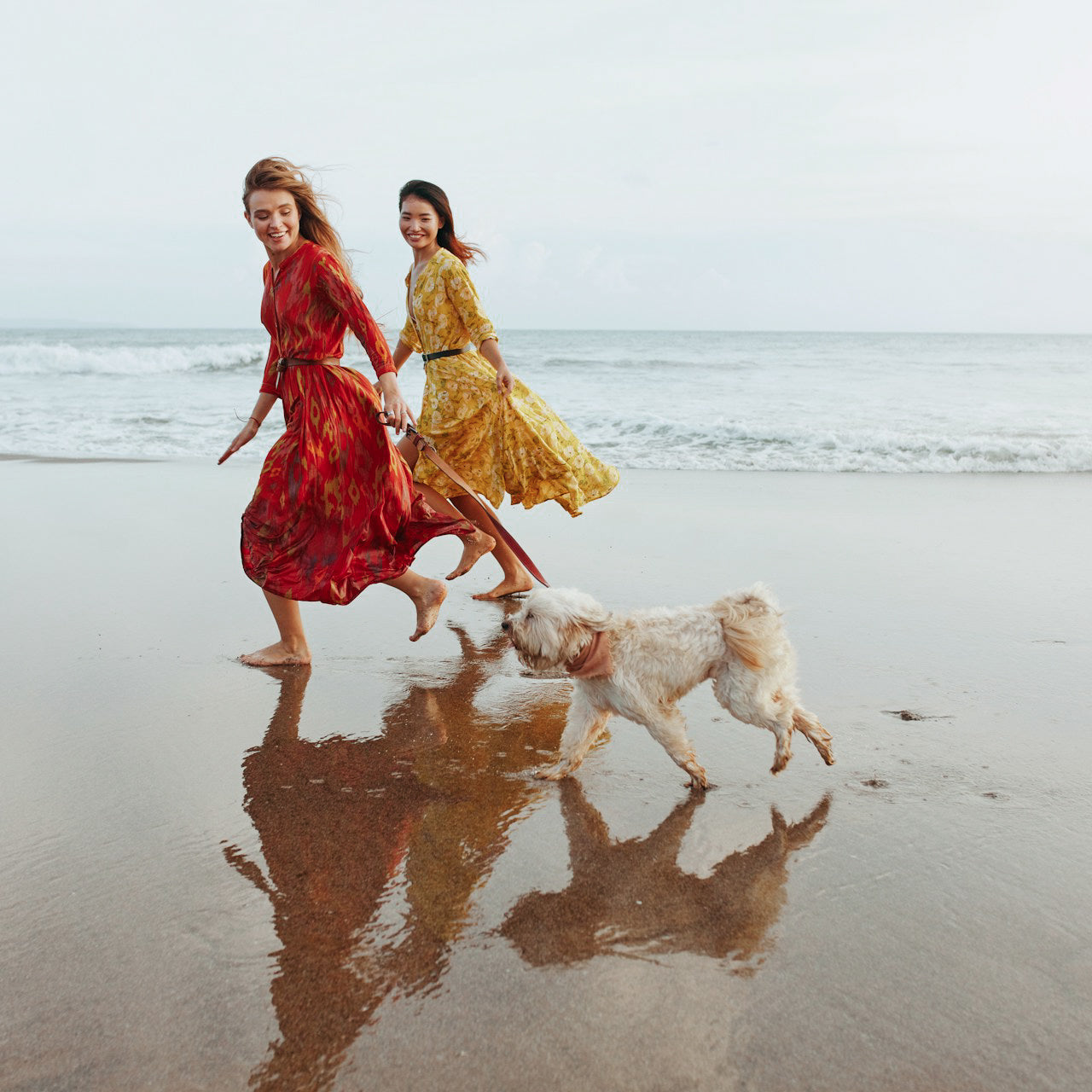Sylt is considered one of Germany's most fascinating islands, attracting numerous visitors every year who appreciate both its breathtaking natural beauty and its fine dining. At the same time, Sylt is also known for its openness to dogs. The island boasts numerous dog-friendly beaches, walking trails, and dog-friendly accommodations. However, a vacation with a dog can only be relaxing if a few essential points are clarified in advance.
Preparation , accommodation , activities , and packing lists are particularly important for ensuring both dog and owner are satisfied. This guide was created to compile all the important information in a compact and clear format. It contains tips from a wide range of areas, from choosing the right season and travel options to the most beautiful dog-friendly beaches Sylt has to offer.
Key take-aways
-
Thorough preparation
Make sure you have all your travel documents (EU pet passport, vaccinations, insurance) and travel accessories in good time. This includes information about arrival and seasonal peculiarities on the island. -
Dog-friendly accommodations
The selection ranges from hotels to vacation apartments to campsites. Pay attention to criteria such as location, amenities (e.g., fenced garden), and possible additional costs for dogs. -
Activities
Sylt offers wonderful dog-friendly beaches, diverse hiking trails, and numerous excursion options. The island's restaurants are also often dog-friendly, as long as basic rules of conduct are followed. -
Packing list
In addition to your dog's documents and medication, you shouldn't forget appropriate leashes, bowls, towels, and toys. Good packing organization prevents stress during your vacation. -
thoughtfulness
Certain rules apply on the island to protect nature and maintain public order. Please observe the leash requirement in sensitive areas and pick up your dog's droppings.
Table of contents
- Preparing for a holiday with your dog on Sylt
- Accommodation with dogs on Sylt
- Activities with dogs on Sylt
- Packing list for a dog holiday on Sylt
- General tips and advice for Sylt with dog
- Conclusion
- Frequently Asked Questions
Preparing for a holiday with your dog on Sylt
Planning and research
Seasons and weather
Sylt is attractive in every season, but certain periods are particularly good for a vacation with your dog. The high season – from June to August – is the busiest and also the most expensive. Those preferring a quieter holiday might prefer the spring (March to May) or autumn (September to November). During these periods, the beaches are much quieter, and the weather can still be pleasantly mild.
-
Spring (March to May)
Spring on Sylt is characterized by increasingly bright days and the gradual warming of the North Sea. It's often windy on walks during this time of year, but generally not crowded. It's an ideal time for long walks on the beach, where your dog can calmly get used to the new surroundings. -
Summer (June to August)
Summer is peak season. Plenty of beach chairs, packed restaurants, and a bustling island atmosphere. Some dogs find the hustle and bustle exciting, while others can be stressed by it. At the same time, it's the warmest time of year, making for wonderful days at the beach. During this time, stricter leash regulations often apply on the beaches to protect all guests and avoid conflicts. -
Autumn (September to November)
Autumn gives the island a very special atmosphere. Nature abounds in impressive hues, and temperatures are usually still pleasant for long walks. Occasional storms can occur, but for many travelers, this is what makes Sylt so appealing. Dog owners have the advantage that the island is less crowded. -
Winter (December to February)
If you want to experience Sylt's rugged, mystical side, travel in winter. The beaches are virtually deserted, and accommodation prices tend to be lower. Wind and weatherproof clothing is a must, however. A winter vacation can be very relaxing and romantic, provided your dog is cold-resistant and enjoys the blustery North Sea wind.
Booking periods and early bird discounts
-
Early booking
Especially if you're looking for accommodation near the beach or with special amenities (e.g., a fenced garden), booking several months in advance is recommended. In popular locations like Westerland, Kampen, or Wenningstedt, dog-friendly accommodations book up quickly during the high season. -
Low season
Those who can avoid school holidays often discover very attractive deals during the off-season. Not only do you have a better chance of finding the perfect vacation home, but you'll often also find cheaper rates. -
Early bird discounts
Some hosts offer attractive early bird discounts. Those who book in late summer for the following year can often benefit from reduced rates. Often, specific dates are specified during which the discount is valid.
Health and travel conditions
Important vaccinations and EU pet passport
Before traveling with a dog within the EU, it's important to ensure that all relevant requirements are met. The following points are particularly important for traveling to Sylt:
-
EU pet passport
This passport serves as proof of the dog's identity (via microchip) and vaccinations. The document is recognized in all EU member states and is mandatory for travel within the EU. -
Rabies vaccination
The rabies vaccination must be valid. A primary vaccination is effective after 21 days; booster vaccinations must be renewed in good time before the expiration date. -
Identification (microchip)
Dogs require a microchip to be uniquely identifiable. This chip is implanted by a veterinarian and registered in a database with a unique number.
It's especially advisable to check the current regulations when crossing borders, for example, when traveling through Denmark or taking a ferry from Rømø to Sylt. Although the requirements are generally the same across the Schengen area, details can sometimes change.
Here you can find further information on EU entry regulations with dogs .
Veterinarians on Sylt and emergency numbers
In an emergency, it's reassuring to know where to find help quickly. There are several veterinary practices on Sylt, whose addresses and emergency hours are available on their respective websites. It's also a good idea to save a list of your most important contacts directly on your phone or keep a printed copy with your travel documents.
-
Regular check-ups before travel
A visit to your vet before your vacation can provide clarity as to whether your dog is fit for the trip. This can also check whether the required vaccinations and deworming treatments are up to date. -
Emergency pharmacy for dogs
In addition to the address of your local veterinarian, we recommend bringing a small first-aid kit with bandages, disinfectant spray, and, if necessary, painkillers (only in consultation with your veterinarian). Tick tweezers or a pair of tick removers should also be included for immediate removal of parasites.
Arrival
Train, car or plane: What is most comfortable for the dog?
-
Arriving by car
Those arriving by car remain flexible. The dog is usually already familiar with the vehicle, which can ensure peace and security. A ride on the car train (Sylt Shuttle) is necessary to reach the island directly via the Hindenburgdamm. Alternatively, the car can be transported by ferry from Rømø (Denmark).-
Advantages : Comfort for the dog (familiar surroundings), flexible stopovers, transport of large luggage (e.g. dog bed, food).
-
Disadvantages : Possible traffic jams on the access roads, costs for the Sylt shuttle or ferry.
-
-
Arriving by train
The passenger train takes travelers directly to Westerland on Sylt. Those who want to travel stress-free and without a car can arrive from Hamburg in about three to three and a half hours. Depending on the size of the dog, a muzzle may be required. With some train fares (e.g., local trains), dogs travel free of charge; however, an additional ticket may be required on long-distance trains.-
Advantages : Relaxed journey without driving yourself, more sustainable than a car.
-
Disadvantages : Dependence on local public transport, restrictions on luggage, muzzle requirement.
-
-
Arriving by plane
Sylt has its own airport near Westerland. Various airlines fly to the island from major German cities. However, flying is often stressful for dogs, especially if they have to be accommodated in the cargo hold.-
Advantages : Quick access from more distant cities.
-
Disadvantages : High costs, limited space for dog transport boxes, stress for the animal.
-
A detailed overview of transport connections on the island can be found, for example, at:
Sylt Marketing - Arrival information
Ferry or Hindenburgdamm: Special features of the crossing
-
Car train (Hindenburgdamm)
Deutsche Bahn's Sylt Shuttle transports vehicles across the Hindenburgdamm. The journey takes approximately 35 minutes. During this time, dog owners remain in the vehicle. This can be less stressful for the dog than changing trains in unfamiliar areas. -
Ferry from Rømø (Denmark)
Those who choose the ferry crossing from Havneby (on the Danish island of Rømø) to List (Sylt) should be aware that the ship occasionally rocks more heavily on the North Sea. Dogs are usually allowed on leashes on deck, which offers the advantage of getting some fresh air.
The ferry can be an interesting alternative for those already traveling from the north or planning a detour to Denmark. For more information, please check the relevant ferry company:
Sylt ferry - information on departure times and conditions
Accommodation with dogs on Sylt
Dog-friendly hotels, holiday apartments and campsites
The selection of accommodations on Sylt is extensive, ranging from luxurious hotels with wellness facilities to spacious holiday apartments and nature-oriented campsites. The following options are particularly suitable for a holiday with your dog:
-
Hotels :
Some hotels on Sylt specialize in welcoming dogs. Often, bowls, dog blankets, and even welcome treats are provided. However, it's advisable to read the respective house rules carefully, as dogs are often only allowed in certain areas (e.g., the lobby, select rooms). -
Holiday apartments :
Very popular with many travelers, this type of accommodation offers a lot of privacy and flexibility. A well-equipped kitchen allows for self-catering, and a fenced garden allows your dog to run free without disturbing neighbors or passersby. Here, too, it's essential to clarify in advance whether the apartment is truly dog-friendly. -
Campsites :
Those who appreciate being close to nature and enjoy getting off the beaten track will find several camping options on Sylt. Some sites allow pets, although leashes may be required on the grounds.
Important criteria for selection
-
Location near the beach or near the city center?
-
Additional charges per dog or multiple dogs allowed?
-
Facilities such as garden, balcony, terrace, dog bed?
-
Possible house rules (e.g. no dogs in the beds)?
Price comparison and booking tips
-
Online portals : Platforms such as FeWo-direkt, Booking.com or special dog travel portals (e.g. “Hunde-Urlaub.net”) show extensive lists of dog-friendly domiciles.
-
Direct booking : Many landlords have their own websites. Direct booking can be cheaper, as there's no commission.
-
Flexibility : Those who can choose arrival dates outside of peak season often get better prices and a wider selection of properties.
Cancellation policies also play a role. A property that allows free cancellation until shortly before departure may represent a higher booking risk for the owner, but it offers travelers peace of mind in case their dog becomes ill or other unforeseen events occur.
Local rules and customs in accommodation
-
Consideration : Dogs should behave quietly so as not to disturb other guests. This is especially true in hotels where thin walls can cause noise.
-
Cleanliness : As a dog owner, you should of course pick up all droppings outside and make sure that neither furniture nor carpets are unnecessarily dirty inside.
-
No long periods alone : Many dogs feel uncomfortable in unfamiliar surroundings when left alone for hours. Some landlords explicitly prohibit this in their house rules.

Activities with dogs on Sylt
The most beautiful dog beaches on Sylt
One of Sylt's main attractions are the miles of beaches that stretch around the island. Fortunately, many of these stretches are dog-friendly. However, in some places, dogs must be kept on a leash, especially during peak season.
The following table provides an indicative selection of the most popular dog beaches and their respective special features:
| Location | Beach section | Special features |
|---|---|---|
| Westerland | Sections 1 and 2 | Good accessibility, often busy, leash required during peak season |
| Rantum | Section 7 | Spacious and quiet, ideal for long walks |
| Kampen | Stage 16 | Popular meeting place, beach bar nearby, dogs must be kept on a leash in some places |
| List | Königshafen | Natural surroundings, dune landscape, somewhat rough North Sea wind |
| Hörnum | Dog beach on the east beach | Idyllic, shallow water, perfect for less experienced dog swimmers |
| Wenningstedt | Beach access main stairs (seasonally marked) | Family-friendly place, dog beach well signposted, great promenade nearby |
Please note that the exact beach areas and regulations (e.g., leash requirements, access restrictions) may change from season to season. A current overview and any changes can be found on the official Sylt website:
Official information on dog beaches on Sylt
Tips for stress-free beach visits
-
Timing :
Beaches are often less crowded in the morning or evening. Visiting during off-peak times provides more space and peace. -
Water and bowl :
Dogs need plenty of fresh water when engaging in activities at the beach. Thirst can quickly increase, especially in warm temperatures. -
Retreats :
Some dogs find the hustle and bustle of the beach exciting. A private parasol or beach chair can provide a shady spot where your dog can relax. -
Respect leash requirements :
Even though free-running is permitted in certain areas, consideration and caution should always be paramount. Other bathers, children, and animals on the beach deserve respectful treatment.
Hiking and walking
In addition to the beaches, numerous hiking and walking trails invite you to explore Sylt with your dog. Among the most beautiful areas are the dune landscapes, the heathland, and the Wadden Sea.
-
Braderup Heath :
A unique natural gem, here you can roam the heathland on marked trails and enjoy sweeping views of the Wadden Sea. Dogs are often required to be kept on a leash to protect the sensitive flora and fauna. -
Elbow in List :
This northernmost tip of Germany boasts high dunes and impressive panoramas. The area appears largely untouched. A walk here can be wonderfully combined with a trip to neighboring Denmark, provided you meet the entry requirements. -
Circular hiking trails :
From the island village into the interior or along the coast – the routes are varied and vary in difficulty. Before setting out, it's worth assessing the length and gradient to avoid overtaxing your dog.
Excursions and experiences
Cycling tours with dogs
Sylt has a well-developed network of cycle paths, making a bike tour one of the highlights of your stay:
-
Cargo bikes and dog trailers
For larger dogs, a trailer is recommended, where they can sit or lie comfortably and safely. Smaller dogs can sometimes fit in the front of a cargo bike. However, a certain adjustment period is necessary for the dog to gain trust. -
Plan a break
Since the climate along the coast can be quite windy, you should plan enough time for rest breaks. A quick stop at the beach or a café gives your dog the opportunity to get some exercise and have a drink.
Special island highlights
-
Lighthouses :
The lighthouses of Kampen and Hörnum are among the island's landmarks. Even though it's usually not possible to visit the interior with your dog, a visit to the area around the towers is worthwhile for a quick photo shoot. -
Local events :
Markets, festivals, and sporting events are held regularly on the island. Dogs are often welcome there, provided they are kept on a leash and behave calmly. -
Guided tours and mudflat hikes :
Guided tours through the mudflats are a truly unique experience. Some operators allow dogs, provided they remain on a leash and do not pose a threat to the wildlife in the mudflats.
A note: When planning special activities, it is advisable to contact the respective operator in advance to ensure that dogs are actually permitted.
Culinary delights and refreshments
Sylt is known for its high-quality culinary delights. Not only in Michelin-starred restaurants, but also in numerous cafés, beach bars, and fish stalls, dogs are welcome.
-
Dog-friendly restaurants :
Often recognizable by water bowls at the entrance or a brief notice on the menu. Upon request, the service staff sometimes even offers small treats. -
Rules of conduct :
Please ensure that dogs behave calmly and do not nudge or bark at other guests. A spot under the table or in a quiet corner is usually the best choice to ensure everyone feels relaxed. -
Local specialties :
Fish sandwiches, Frisian cake, and other Nordic delicacies are typical of Sylt. Of course, these are not suitable for dogs, so if in doubt, it's better to offer your own food.
Packing list for a dog holiday on Sylt
A carefully compiled packing list is the key to a stress-free vacation, as not all the necessary items are often available locally in the same quality or at reasonable prices.
Important documents and medications
-
EU pet passport :
Essential for travel within the EU. Contains information about vaccination status and chip number. -
Proof of insurance :
Dog liability insurance is mandatory in many federal states and also makes sense when traveling to protect yourself against eventualities. -
First aid kit :
Bandages, disinfectants and, if necessary, medications prescribed by veterinarians.-
Tick tweezers or tick remover
-
Light gauze bandages
-
Disinfectant spray
-
-
Regular medications :
Dogs that depend on certain medications should have a sufficient amount available for the entire journey.
equipment
-
Food and water bowls :
Foldable bowls made of silicone or lightweight plastic are particularly practical. -
Leashes (various lengths) :
A short leash for downtown or restaurant visits, a longer or towable leash for off-leash areas. -
Harness or collar :
The harness should fit well and not chafe, especially when the dog is on a leash for longer walks or hikes. -
Blanket or basket :
A familiar place to sleep ensures more relaxation. -
Toys :
One or two favorite toys to keep them busy. Beach toys like floatable balls can also be useful.
Useful extras
-
Towels :
Absorbent towels for wet or dirty paws, especially useful after a visit to the beach. -
Poop bags :
A must-have in every bag to keep the beach and public paths clean. -
Cooling mat or cooling collar :
Especially in summer, the heat can be exhausting for dogs, and a cooling mat offers a little refreshment. -
Muzzle :
A muzzle may be required on some public transport (e.g., certain trains or buses) or abroad (e.g., when traveling through Denmark). Getting used to it early on will prevent stress.
General tips and advice for Sylt with dog
Consideration for other holidaymakers and nature
Sylt thrives not least on tourism and its unique landscape. To ensure the island remains so beautiful, respectful treatment is essential:
-
Leash requirement :
In nature reserves and during certain breeding and nesting seasons (often spring and early summer), dogs must be kept on a leash. Signs usually clearly inform the local authorities about the regulations. -
Remove leftovers :
Numerous dog waste bag dispensers and trash cans are located along the trail. Proper disposal of dog waste is essential to keeping the beach and dunes clean. -
Respect the ecosystem :
The dunes, in particular, are a sensitive system. It is recommended to stay on the designated paths to ensure the best possible protection of plants and animals.
Dog schools and training opportunities on site
Some dog schools on Sylt offer courses specifically tailored to holiday guests, such as group beach training or group leash training sessions. This can be an opportunity to mentally challenge your dog while on vacation and meet like-minded people at the same time.
-
Group courses :
Often with fixed times, so you should ask about free places in good time. -
Individual lessons :
If you would like to work specifically on certain behaviors or discuss problems, you can book individual lessons. -
Socialization :
A vacation destination with many unfamiliar stimuli can be a good opportunity to work on getting your dog used to different situations.
Insurance and possible risks
-
Dog liability insurance :
Damage caused by a dog (e.g., in the holiday home or to third parties) can be costly. Dog liability insurance is therefore essential. -
Travel cancellation insurance :
Some insurance companies offer plans that also include your dog. If your pet's illness makes your vacation impossible at short notice, such a policy may cover you. -
Veterinary visits :
In rare cases, a short-term veterinary visit may be necessary. Since veterinary treatments can be expensive, it's advisable to bring your health insurance documents (if available) with you.
Helpful contacts on Sylt
Just in case, it is a good idea to have some important addresses and phone numbers ready:
-
Veterinary practices :
There are several veterinarians on Sylt, for example in Westerland or Tinnum. -
Dog groomers :
After stormy days at the beach, a dog groomer can not only make your dog look beautiful, but also help with matted fur. -
Pet sitter :
If you're planning a restaurant visit where dogs aren't welcome, some locals offer pet-sitting services. Asking at the accommodation agency or tourist office can help.
Conclusion
A vacation with your dog on Sylt is a wonderful way to combine leisure, nature, and shared relaxation. The island offers a wide range of activities – from beach walks and bike rides to exploring the dunes and heathland together. Thanks to numerous dog-friendly accommodations and restaurants, owners don't have to worry about finding somewhere to accommodate their beloved four-legged friend.
Nevertheless, it's advisable to plan some aspects thoroughly in advance. Detailed research on entry and vaccination requirements, choosing the right time of year to travel, and booking suitable accommodation early are essential foundations for a smooth trip. On Sylt itself, there are many dog beaches with clear regulations thanks to designated areas. Whether it's Westerland, Rantum, Kampen, Hörnum, Wenningstedt, or List – all locations have their own unique charm and offer diverse natural scenery for humans and animals.
In addition to beach visits and hikes, other worthwhile activities include bike tours with a special trailer or a trip to the famous lighthouses. To ensure the well-being of holidaymakers, there are also numerous restaurants and cafés that accept dogs or even welcome them with special services. A well-thought-out packing list will prevent important items (such as a valid EU pet passport, medication, or sufficient leashes) from being left behind. With this equipment, nothing stands in the way of a relaxing island vacation.
In summary, thanks to a perfect combination of nature, hospitality, and dog-friendly infrastructure, Sylt is one of the most popular travel destinations for dog owners from all over Germany. Good planning, respect for nature and fellow human beings, and the willingness to consciously enjoy your vacation are the best prerequisites for experiencing the North Sea island at its best.
Good luck implementing these tips and have a relaxing stay on Sylt – both for you and your faithful companion!






